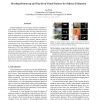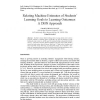1405 search results - page 77 / 281 » Learning Instance-Specific Predictive Models |
CVPR
2012
IEEE
11 years 11 months ago
2012
IEEE
Despite significant recent progress, the best available visual saliency models still lag behind human performance in predicting eye fixations in free-viewing of natural scenes. ...
ICIP
2009
IEEE
13 years 6 months ago
2009
IEEE
Wyner-Ziv video coding (WZVC) is a new paradigm for video compression with the prediction frames possibly only available at the decoder. It exploits the statistics between the sou...
ANLP
2000
13 years 10 months ago
2000
The eventual goal of a language model is to accurately predict the value of a missing word given its context. We present an approach to word prediction that is based on learning a...
AIED
2007
Springer
14 years 3 months ago
2007
Springer
Students’ actions while working with a tuoring system were used to generate estimates of learning goals, specifically, the goal of learning by using multimedia help resources, an...
WWW
2005
ACM
14 years 9 months ago
2005
ACM
Autonomics or self-reorganization becomes pertinent for websites serving a large number of users with highly varying workloads. An important component of self-adaptation is to mod...


